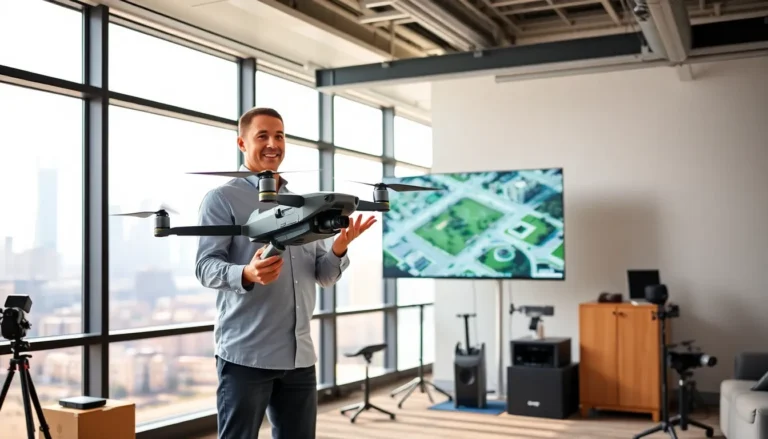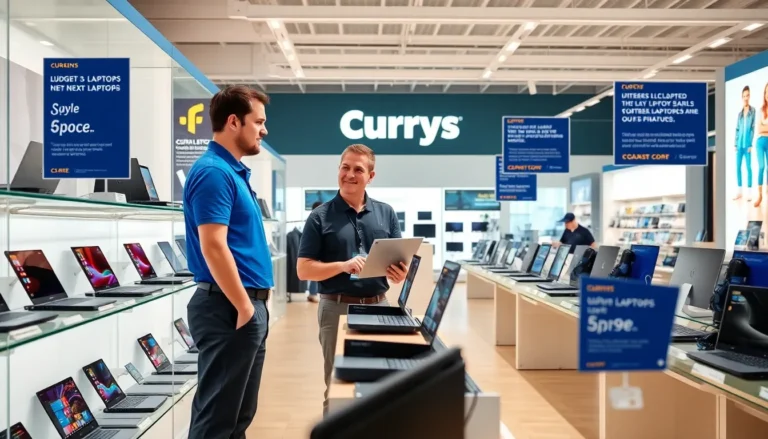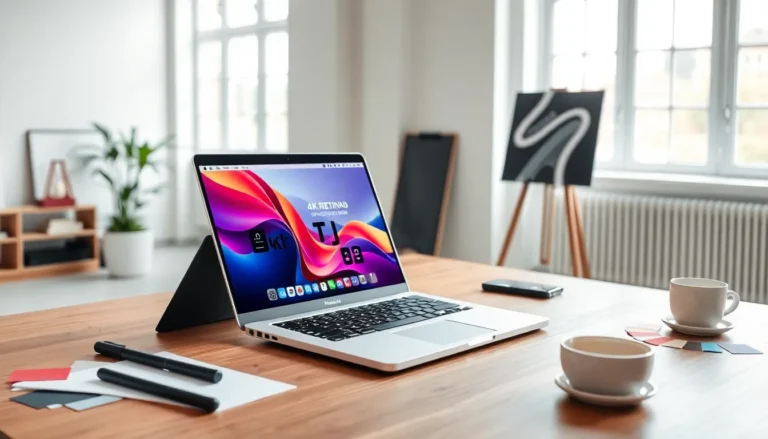In a world where tech options seem endless, the battle between Chromebooks and traditional laptops rages on. Picture this: a sleek Chromebook, lightweight and ready to tackle the cloud, versus a robust laptop, equipped to handle anything from spreadsheets to video games. It’s like choosing between a trusty bicycle and a powerful sports car—both get you where you need to go, but the journey feels quite different.
Table of Contents
ToggleOverview of Chromebooks and Laptops
Chromebooks operate primarily on Google’s Chrome OS, which focuses on web-based applications. Designed for light usage, they tend to excel in tasks like browsing, streaming, and using cloud services. Their simplicity appeals to many users, especially students and casual surfers.
Laptops, on the other hand, run various operating systems, such as Windows or macOS. These traditional computers typically feature more powerful processors and more storage options, allowing for resource-intensive tasks. Users benefit from diverse applications, including programming software and graphic design tools.
Price points vary significantly between the two. Most Chromebooks come at a lower cost than traditional laptops, making them accessible for budget-conscious individuals. They often suffice for educational purposes, while laptops provide more versatility.
Battery life represents another crucial difference. Chromebooks often offer longer battery life due to their lightweight operating systems. Laptops can sometimes struggle to keep pace, especially when engaging in demanding processes.
Lastly, users desiring offline capabilities might find laptops more suited to their needs. While many Chromebooks allow for limited offline access, full functionality typically requires an internet connection. Each option serves distinct preferences, catering to different lifestyles and usage requirements.
Key Differences Between Chromebooks and Laptops

Chromebooks and laptops serve different needs and preferences with their unique features. Understanding these differences helps users make informed decisions.
Operating Systems
Chromebooks run on Chrome OS, which focuses on speed and simplicity. Users experience quick boot times and automatic updates with this cloud-centric operating system. Laptops, however, typically operate on Windows, macOS, or Linux, offering a more comprehensive range of features and greater system customization. While Chrome OS predominantly relies on web applications, operating systems like Windows or macOS allow access to powerful desktop applications, catering to more demanding tasks.
Hardware Specifications
Chromebooks usually feature lower-end hardware specifications compared to traditional laptops. Lightweight components contribute to portability and lower prices, appealing to students and casual users. Laptops, in contrast, often include powerful processors, larger RAM capacities, and extended storage options. The superior hardware capabilities make laptops suitable for resource-intensive applications such as video editing and programming.
Software Availability
Software availability distinguishes these two types of devices. Chromebooks primarily support web-based applications and a limited selection from the Google Play Store. Users might find that basic functionalities suffice for everyday tasks like browsing and document editing. Laptops, on the other hand, support a broader range of software, including powerful programs for creative professionals and developers. Access to diverse operating systems and applications makes laptops versatile for various uses.
Use Cases for Chromebooks
Chromebooks excel in specific use cases, particularly in educational settings and casual environments.
Education Sector
Chromebooks have become popular in schools due to their affordability and ease of use. Students benefit from simple interfaces, allowing quick access to learning materials. Features like automatic updates ensure devices remain secure without requiring extensive IT support. Teachers appreciate the ease of managing multiple devices and integrating Google apps for collaborative projects. Many educational institutions prefer these devices because they enable seamless internet-based learning while minimizing distractions. In fact, over 30 million Chromebooks are utilized in schools worldwide, promoting a tech-friendly learning environment.
Casual Use
For casual users, Chromebooks deliver a streamlined experience ideal for web browsing, streaming, and social media. Lightweight designs allow easy portability, making them convenient for on-the-go individuals. Battery life often exceeds 10 hours, supporting long use without frequent charges. Simple navigation and fast boot times further enhance the overall user experience. Users can also access thousands of apps through the Google Play Store, enriching their options for entertainment and productivity. Due to these features, casual users find Chromebooks appealing for everyday tasks without the complexity of traditional laptops.
Use Cases for Laptops
Laptops cater to various use cases, making them preferred choices for diverse tasks.
Professional Environments
In professional settings, laptops prove essential for productivity and performance. Employees use them for tasks such as data analysis, document creation, and video conferencing. Power users benefit from robust CPUs and extensive storage options, allowing seamless multitasking and running resource-heavy software. Many businesses rely on Windows or macOS-based laptops for compatibility with industry-standard applications. Statistics indicate that 90% of corporate environments utilize traditional laptops, highlighting their significance in workspaces. Team collaboration often leverages enhanced screen sizes and keyboard layouts found in laptops, fostering effective communication among co-workers.
Gaming and Performance
Gaming enthusiasts gravitate towards laptops due to high performance and superior graphics capabilities. Many gaming laptops boast advanced GPU technology, enabling immersive experiences in modern games. With refresh rates often exceeding 144Hz, gamers enjoy smoother visuals during intense gameplay. Additionally, high RAM configurations offer better processing power and improved frame rates. Various brands cater specifically to gaming audiences, providing customizable options for hardware setups. According to reports, gaming laptops accounted for a significant 22% of the global laptop market in 2022, reinforcing their role in today’s entertainment landscape. Serious gamers appreciate the balance of portability and performance, allowing them to play across diverse environments.
Choosing between a Chromebook and a traditional laptop ultimately hinges on individual needs and preferences. For those who prioritize simplicity affordability and cloud-based tasks Chromebooks stand out as an excellent option. Their lightweight design and longer battery life make them perfect for students and casual users.
On the other hand traditional laptops offer the power versatility and extensive software support required for demanding tasks. Professionals gamers and creative individuals often benefit from the advanced capabilities that laptops provide.
Understanding these differences allows users to make informed decisions that align with their specific requirements and lifestyle choices. Each device has its strengths making it essential to evaluate personal usage patterns before making a purchase.





